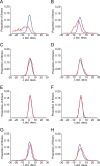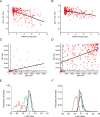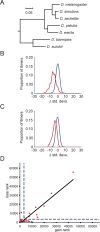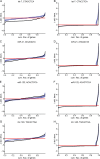Evolutionary dynamics of microRNA target sites across vertebrate evolution
- PMID: 32012152
- PMCID: PMC7018135
- DOI: 10.1371/journal.pgen.1008285
Evolutionary dynamics of microRNA target sites across vertebrate evolution
Abstract
MicroRNAs (miRNAs) control the abundance of the majority of the vertebrate transcriptome. The recognition sequences, or target sites, for bilaterian miRNAs are found predominantly in the 3' untranslated regions (3'UTRs) of mRNAs, and are amongst the most highly conserved motifs within 3'UTRs. However, little is known regarding the evolutionary pressures that lead to loss and gain of such target sites. Here, we quantify the selective pressures that act upon miRNA target sites. Notably, selective pressure extends beyond deeply conserved binding sites to those that have undergone recent substitutions. Our approach reveals that even amongst ancient animal miRNAs, which exert the strongest selective pressures on 3'UTR sequences, there are striking differences in patterns of target site evolution between miRNAs. Considering only ancient animal miRNAs, we find three distinct miRNA groups, each exhibiting characteristic rates of target site gain and loss during mammalian evolution. The first group both loses and gains sites rarely. The second group shows selection only against site loss, with site gains occurring at a neutral rate, whereas the third loses and gains sites at neutral or above expected rates. Furthermore, mutations that alter the strength of existing target sites are disfavored. Applying our approach to individual transcripts reveals variation in the distribution of selective pressure across the transcriptome and between miRNAs, ranging from strong selection acting on a small subset of targets of some miRNAs, to weak selection on many targets for other miRNAs. miR-20 and miR-30, and many other miRNAs, exhibit broad, deeply conserved targeting, while several other comparably ancient miRNAs show a lack of selective constraint, and a small number, including mir-146, exhibit evidence of rapidly evolving target sites. Our approach adds valuable perspective on the evolution of miRNAs and their targets, and can also be applied to characterize other 3'UTR regulatory motifs.
Conflict of interest statement
The authors have declared that no competing interests exist.
Figures








Similar articles
-
Evolution of Hox post-transcriptional regulation by alternative polyadenylation and microRNA modulation within 12 Drosophila genomes.Mol Biol Evol. 2011 Sep;28(9):2453-60. doi: 10.1093/molbev/msr073. Epub 2011 Mar 24. Mol Biol Evol. 2011. PMID: 21436120
-
Reprogramming of 3' untranslated regions of mRNAs by alternative polyadenylation in generation of pluripotent stem cells from different cell types.PLoS One. 2009 Dec 23;4(12):e8419. doi: 10.1371/journal.pone.0008419. PLoS One. 2009. PMID: 20037631 Free PMC article.
-
The Binding Sites of miR-619-5p in the mRNAs of Human and Orthologous Genes.BMC Genomics. 2017 Jun 1;18(1):428. doi: 10.1186/s12864-017-3811-6. BMC Genomics. 2017. PMID: 28569192 Free PMC article.
-
Small but influential: the role of microRNAs on gene regulatory network and 3'UTR evolution.J Genet Genomics. 2009 Jan;36(1):1-6. doi: 10.1016/S1673-8527(09)60001-1. J Genet Genomics. 2009. PMID: 19161940 Review.
-
3'UTRs take a long shot in the brain.Bioessays. 2014 Jan;36(1):39-45. doi: 10.1002/bies.201300100. Epub 2013 Sep 20. Bioessays. 2014. PMID: 24115048 Free PMC article. Review.
Cited by
-
Binding sites of miRNA on the overexpressed genes of oral cancer using 7mer-seed match.Mol Cell Biochem. 2022 May;477(5):1507-1526. doi: 10.1007/s11010-022-04375-7. Epub 2022 Feb 18. Mol Cell Biochem. 2022. PMID: 35179676
-
The miR-181 family: Wide-ranging pathophysiological effects on cell fate and function.J Cell Physiol. 2023 Apr;238(4):698-713. doi: 10.1002/jcp.30969. Epub 2023 Feb 13. J Cell Physiol. 2023. PMID: 36780342 Free PMC article. Review.
-
[Research advances on the role of competing endogenous RNAs in wound healing].Zhonghua Shao Shang Yu Chuang Mian Xiu Fu Za Zhi. 2022 Jan 20;38(1):84-89. doi: 10.3760/cma.j.cn501120-20201125-00498. Zhonghua Shao Shang Yu Chuang Mian Xiu Fu Za Zhi. 2022. PMID: 35152689 Free PMC article. Chinese.
-
Evolution of miRNA-Binding Sites and Regulatory Networks in Cichlids.Mol Biol Evol. 2022 Jul 2;39(7):msac146. doi: 10.1093/molbev/msac146. Mol Biol Evol. 2022. PMID: 35748824 Free PMC article.
-
Rapid adaptation of cellular metabolic rate to the MicroRNA complements of mammals and its relevance to the evolution of endothermy.iScience. 2023 Dec 21;27(2):108740. doi: 10.1016/j.isci.2023.108740. eCollection 2024 Feb 16. iScience. 2023. PMID: 38327773 Free PMC article.
References
Publication types
MeSH terms
Substances
Grants and funding
LinkOut - more resources
Full Text Sources

